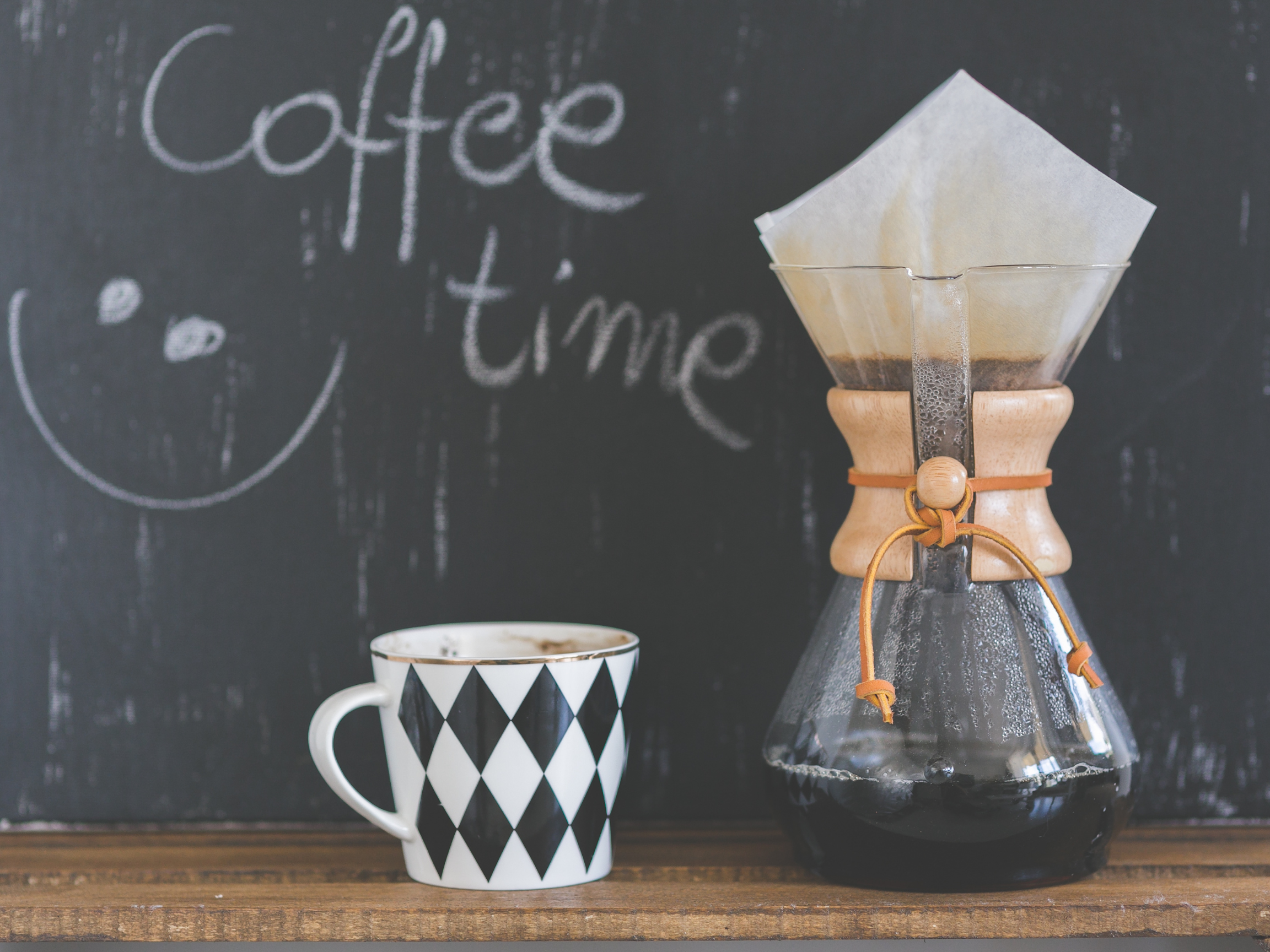Feeling overwhelmed by the world of coffee brewing? French press, pour over, AeroPress … the options seem endless! This guide cuts through the confusion, helping you choose the best brewing method for your taste and lifestyle. We’ll break down the pros and cons of a variety of popular brew methods, give a general price guide and empower you to upgrade your at-home coffee brewing game.
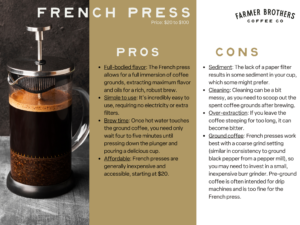
Also called a press pot, coffee plunger or cafetière, the French press is often a person’s first foray into brewing coffee with something other than a coffee maker. It’s inexpensive, easy to use, and brews up a hearty cup of coffee with a thick body – great if you love a strong, black brew or want something that holds up to a hefty portion of milk and sugar.
The very first patent of a device resembling what we use today, called a cafetière (coffee maker) by its inventors, made it to the French patent office back in 1852. The design lacked a proper seal, however, so coffee grounds would often end up in a person’s cup. It wasn’t for another hundred years that, in 1958, an Italian designer named Faliero Bondanini created what he called the “Chambord.” This new design, which quickly gained in popularity in Europe, is recognizable today – a cylindrical glass carafe wrapped with a metal frame, a round ball perched atop a steel rod that raises and lowers the silver mesh filter within.
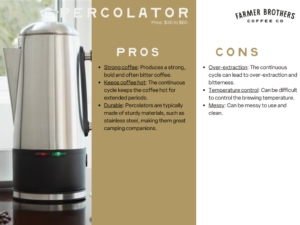
The percolator, while popular in American households in the early and mid-20th century, has largely fallen out of favor since drip coffee makers gained popularity in the 1970s. First invented by a Parisian tinsmith in 1819, the percolator brewed coffee using a bit of modern alchemy.
Inside the kettle-like pot is a metal stem rising from the center. Toward the top of the pot, this stem ends at the top of a metal basket that contains the ground coffee. When the percolator is placed on the stove, the water at the bottom heats up and due to pressure differentials begins to rise up the stem until it reaches the basket, where it falls over and percolates through the ground coffee. The brew then drips into the bottom of the pot and the cycle continues over and over again until the kettle is removed from the heat. Percolators often feature an iconic glass bulb at the top, through which the coffee can be seen “perking” or bubbling as the brew process cycles.
This process can quickly produce a very strong, often over-extracted and bitter cup of coffee, due to the high temperature of the boiling water and the continuous brewing cycle.
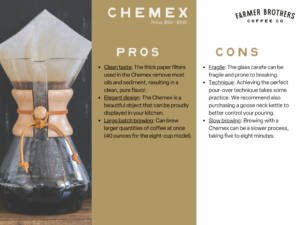
Invented in the United States by Peter Schlumbohm in 1941, the Chemex (pronounced “kim-ecks”) has remained a cultural icon in the world of coffee. Lauded as “one of the best-designed products of modern times,” it can be seen on display in the Museum of Modern Art in New York and in popular television shows and movies, including Friends, The Mary Tyler Moore Show, James Bond’s From Russia With Love and the sci-fi blockbuster Interstellar.
The hand-blown hourglass design with wooden collar and leather strap hasn’t changed since its creation more than 80 years ago and still brews a delicious and clean cup of coffee. Outside of its unique design, the Chemex utilizes thick bonded paper filters, which filter out more oils and sediment than traditional paper filters, creating a clean, medium-bodied cup of coffee with nuanced flavors.
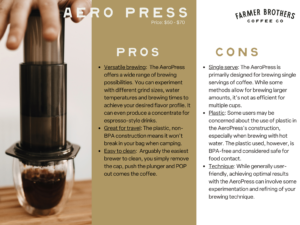
As a niche or hobbyist brew method, we wouldn’t be surprised if you hadn’t heard of the AeroPress. Invented in the early 2000s by Stanford’s Alan Adler (known also for his long-flying frisbee-like Aerobie discs) the AeroPress lands somewhere between a syringe, a French press and an espresso maker, without being either of the three. It’s praised in the coffee community for the diversity of ways one can brew with it, so much so yearly competitions celebrate the person with the best brew on a world stage.
Brew inverted or upright. Use finely ground coffee and a short brew time or coarse ground coffee with a longer steep. Stir ten times or swirl for 10 seconds – there is no end to the recipes or ways to brew. Consisting of a wide, syringe-like plunger, first a circular flat filter is rinsed and placed over the screen of the brewer. Next, coffee is added, water is poured and then, when ready, the plunger is slowly pressed down. The resulting cup, whether espresso-like in strength or just like a regular coffee, will be small – 10 ounce or less – making this best for a single individual.
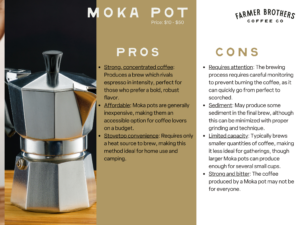
Named for the Yemini port city of Mokha, the Moka pot, with its distinctive octagonal shape, is an icon of Italian coffee culture. Invented in 1933 by Luigi Di Ponti, it was inspired by the steam-powered washing machines of the time. The design works similarly to a percolator, but without the recirculation. Heated water becomes pressurized to steam, traveling up through a metal stem and through a compacted coffee bed, finally out into the brew chamber on top. This produces a strong, thick coffee akin to espresso, great for a quick pick-me-up or for pairing with milk.
The Moka pot quickly became a staple in Italian households and has since spread its popularity across the globe, remaining a beloved and affordable way to enjoy strong coffee.
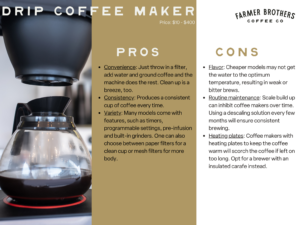
Filter coffee as we know it came to be when Melitta Benz, a German mother, who became fed up with the thick, bitter coffee available at the turn of the 20th century. Her solution? She punched holes in a tin can, lined it with blotting paper and created the first rudimentary coffee filter. This simple act revolutionized coffee brewing, leading, eventually, to the development of the modern drip coffee maker.
Fast forward to the 1970s and automatic drip coffee makers, such as the iconic Mr. Coffee, became a staple in American kitchens. Today, these machines of convenience offer a wide array of features at a variety of price points from programmable timers and built-in grinders to single-serve options and large carafes. Choosing the right brewer comes down to personal preference.
For those seeking a quality cuppa, look for coffee makers with the Gold Cup Certification. This designation from the Specialty Coffee Association (SCA) indicates the machine has been rigorously tested and meets their standards for optimal brewing time and temperature, ensuring consistently delicious coffee for you and your guests.
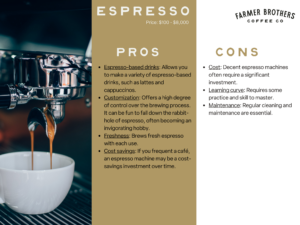
Contrary to what you might think, espresso machines pre-date filter coffee, but didn’t gain in popularity in Europe until the 1940s. Created from the desire to produce a strong and heavily caffeinated cup without the wait time, espresso (which comes from the Italian esprimere, “to press/squeeze out”) is made by forcing hot water through finely ground and compacted coffee at high pressure. The resulting beverage is small but impactful, adorned with a beautiful cascading golden foam when brewed well, called “crema,” which houses the majority of an espresso’s aromatics.
While the AeroPress and Moka pot produce coffee which may mimic espresso, nothing can make a true espresso like an espresso machine. With a high price point and steep learning curve, espresso machines can be intimidating for some, but a fun at-home hobby that could save you money over time if you’re a frequent patron to the local café.
Ultimately, the best coffee brewing equipment for you depends on your individual preferences and priorities. Consider factors like the desired strength and flavor of your coffee, your budget, and your willingness to learn new techniques. With so many options available, you’re sure to find the perfect brewer to help you start your day with the perfect cup of coffee.
